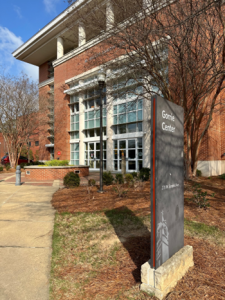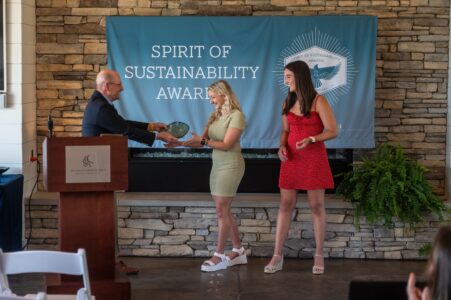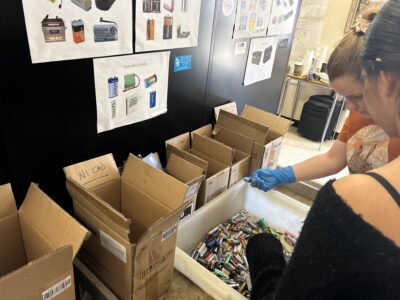“The organizations that truly lead…will be those who convert sustainability challenges into compelling strategic opportunities.” ~ Peter Senge

Mike and Aubie at the Sustainability Picnic.
For years, I had a habit of checking sustainability job boards even when I was not seeking a new position. I recall seeing in the early 2000s a rising wave of job postings for the new position of sustainability officer in colleges and universities across the country. (The business community had started this effort about ten years earlier.)
I watched as this wave grew throughout the first decade of the 21st century, cresting, as I recall, around 2007 or 2008 before getting close to saturating an initial hiring on campuses everywhere. Sustainability in higher education job postings continue to show up, but now they are mostly for expanding office staff or hiring replacements rather than hiring a first sustainability officer.
It is remarkable how, in less than 20 years, sustainability offices have become, like an Ombuds Office or Human Resources Department, an expectation in higher education, impacting teaching, research, outreach, operations, and administration at colleges and universities in the United States and around the world.
Auburn University began exploring sustainability in 2002 thanks to College of Human Sciences Dean June Henton and College of Architecture Design & Construction Dean Dan Bennett. They formed a Sustainability Task Force to explore what sustainability at Auburn should look like, and in 2003, a Sustainability Initiative was created.

Students connecting at the Sustainability Picnic.
In 2009 Chief Executive Officer Don Large established the Office of Sustainability, which was initially led by history professor Lindy Biggs, who had been involved in the Task Force and Initiative. Remarkably, while maintaining her duties as a professor, Lindy created the office from scratch to develop plans, policies, and processes, improve operations, and engage the campus community in the sustainability transformation. She and her staff also found time to create the Minor in Sustainability Studies. Impressive!
Lindy retired in 2011, and I was hired as the first full-time director of the Office of Sustainability, with a staff that includes a Program Manager and a Communications & Outreach Manager. At the same time, the Academic Sustainability Program (ASP) was created and overseen by COSAM professor Nanette Chadwick, who was given a 60% appointment to direct the ASP. The current ASP Director is community planning professor Becki Retzlaff.
In 2005, there were enough colleges and universities with sustainability offices that the Association for the Advancement of Sustainability in Higher Education (AASHE) was formed. AASHE is an incalculably valuable learning community, resource, and advocate for sustainability in higher education.
At the same time, numerous regional groups grew among sustainability officers to create communities of practice to help each other advance sustainability at their respective institutions. In the Southeast, for example, the Southeast Campus Sustainability Network is a wise and wonderful group of sustainability colleagues from campuses, large and small, stretching from Virginia to Florida to Louisiana. We meet online every month and hold an in-person summer workshop at one of our campuses. It is perhaps my most valuable group of sustainability colleagues, outside my colleagues in the Office itself.
As offices were established and grew, sustainability officers began asking “How do we know what we should be doing?” “What do we measure and how do we measure it?” “How do we compare in sustainability performance with our peer institutions?”

The M. Miller Gorrie Center, Auburn’s first LEED certified building, received LEED Gold in 2008.
As a result, in 2008 the Sustainability Tracking Assessment & Rating System (STARS) what created to enable institutions to answer these questions. STARS is a powerful tool to assess what and how well we are implementing sustainability initiatives and identify next opportunities for progress. Relying on units across campus for data, the Office, in partnership with the ASP, is about to complete our fifth comprehensive sustainability performance assessment using STARS.
Because Auburn is an AASHE member, anyone with an auburn.edu email address can create an account at AASHE and tap a cornucopia of resources across a comprehensive set of sustainability-related topics as well as view the sustainability performance assessment at Auburn and many other institutions.
Virtually every one of our peer institutions has a sustainability infrastructure, including offices and academic initiatives, at least as strong as Auburn’s. Each one of the benchmark institutions referenced in the development of Auburn’s new Strategic Plan – University of Virginia, Virginia Tech, Purdue, Rice, University of Texas at Austin, and Arizona State – has strong sustainability initiatives.
By way of example, in February of 2022, the President and the Provost of Rice University in Houston, Texas, sent a message to the university community that stated in part: “With this message, we are establishing our commitment to sustainability as an overarching policy that spans all facets of the university’s actions.”
This is remarkably like the language in the Auburn University Sustainability Policy: “Auburn University commits to integrating sustainability into all aspects of the university. Auburn University considers sustainability a core value and strives for excellence in sustainability through continuous assessment and improvement.”

Spirit of Sustainability Awards Ceremony.
Proclamations and written policies are great, but it is the actionable implementation that gives these commitments their legitimacy.
That is where offices of sustainability in higher education come in. Sustainability offices are the catalysts, facilitators, conveners, and advocates to ensure that actions result from commitments. It is our job to create a shared understanding of what sustainability is and why it matters, then identify ways to take action.
Sustainability offices are the only units on campuses with an overarching view of sustainability in all its forms, with an accompanying overarching responsibility to look for and seize opportunities for progress. These offices are the only comprehensive go-to resource for sustainability information and expertise to guide and assist students, faculty, the administration, and operational units in their efforts.
For one example, here at Auburn, the Office of Risk Management & Safety recently reached out to the Office of Sustainability asking for a partnership to establish a Green Labs Program. Naturally, we jumped at the chance to help make this high-leverage program a reality. The Office has eagerly committed our resources and relationships to develop and implement the Program.

Properly sorting batteries for the Battery Recycling Program.
It is our experience that the community at large also values our work, as individuals, groups, elected officials and city staff members regularly reach out for advice, information, and make requests for help. Alumni too connect with us, for advice on careers, for information, for introductions to faculty and staff, to stay connected to their alma mater. In fact, a group of alumni created the Sustainability Auburn Alumni Affiliate group a couple of years ago.
So, how else do sustainability offices contribute to institutional mission and priorities?
For one thing, they help prepare students for the workforce they will be entering. As Yale law professor and former Commissioner of the Connecticut Department of Energy and Environmental Protection Dan Esty put it in a message to the business community, “In this new world, the sustainability strategy imperative will be systematized and integrated into the day-to-day practices of firms of all sizes in all industries. Like the IT and quality megatrends, sustainability will touch every function, every business line, every employee. On the way to this future, firms with a clear vision and the execution capabilities to navigate the megatrend will come out ahead. Those that don’t will be left by the wayside.”
Just last year, I heard a Mercedes Benz vice president echo this thought, declaring that Mercedes needs not just engineers, but people in every unit within the company to understand and operationalize its sustainability commitments if they are to be successful and profitable.
For another example of how business is prioritizing sustainability and why students must be prepared to contribute as employees, check out this inspiring and hilarious video of Apple CEO Tim Cook and his staff reporting on their climate initiatives to Mother Nature (played by another Auburn graduate, Octavia Spencer).
To prepare our office interns for this “new world,” we invest considerable effort in our internship program teaching our students about the principles, practices, and ethics of sustainability. We also teach them about being effective leaders and change agents and how to engage others on behalf of the common good. They leave their internships better prepared to make a difference.
Sustainability contributes to operational efficiencies and innovations, campus health and wellbeing initiatives, and ensuring that everyone feels “welcomed, valued, respected, and engaged.”
Sustainability offices support faculty in many ways, as a resource, collaborating on conferences and symposia, lecturing in classes, providing letters of support for grant proposals and promotion and tenure, and more. Academic sustainability programs prepare faculty and educate students and help expand an innovative, collaborative, systems-oriented, and transdisciplinary approach to teaching and research.
It has been said that people are motivated either by aspiration or by desperation. People who comprise sustainability offices take the aspirational approach and bring a positive energy to the campus community.
We ask Marvin Weisbord’s question: “What’s possible, and who cares?”
We agree with a sentiment expressed by Franklin Delano Roosevelt almost 100 years ago: “We have always held to the hope, the belief, the conviction that there is a better life, a better world, beyond the horizon.”




